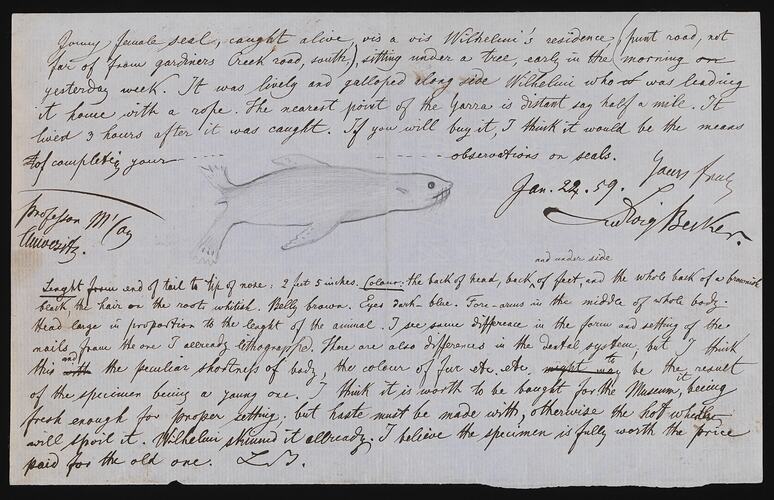Australian Fur Seal, Arctocephalus pusillus doriferus
Plate 31. Australian Sea-Bear or Fur-Seal, Euotaria cinerea (now known as Australian Fur Seal, Arctocephalus pusillus doriferus). All the specimens described were killed at the Heads, Near Queenscliff.
The Hon. David Moore has kindly furnished me with a great deal of valuable information respecting the old trade at Sydney in the Fur-Seals of this species. The males he mentions were more valuable than the others; these were entered in the invoices under the trade term of "Wigs," the females entered as "Klapmatches," and the young as "Pups." The trade, he informs me, has now entirely ceased in New South Wales, Victoria, and South Australia, partly from the animals being scared away by the traffic of a multitude of steamers and other vessels, and partly of the greater scarcity of labour no longer leaving it profitable to pay a sufficiently numerous crew of a vessel to man the several boats required. Colonel Champ also informs me that five-and-twenty years ago he used to see several of the islands between the Tasmanian and Victoria shores covered with numbers of the Fur-Seals, of which it is rare circumstances to see a single individual now in the localities where they were so common formerly.
I subjoin in foot-note an amusing notice of one of the young specimens now in the Museum, written by the late clever observer and artist, Ludwig Becker*.
* "Professor McCoy. University 24th January 1859.- Young female Seal, caught alive, vis-a vis Wilhelmi's residence (Punt road, not far off from Gardner's Creek road, south) sitting under a tree in the morning yesterday week; it was lively and galloped alongside Wilhelmi, who was leading it home with a rope. The nearest point of the Yarra is distant say half-a-mile. It lived three hours after it was caught. If you will buy it, I think it would be the means of completing your observations on Seals. - Yours truly, (signed) Ludwig Becker.
"Length from end of tail to tip of nose, 2 feet 5 inches. Color: the back of the head, back and under side of feet, and the whole back, of a brownish-black; the hair on the roots whitish; belly brown; eyes dark-blue. Forearms in the middle of whole body. Head large in proportion to the length of the animal. I see some differences on the form and setting of the nails from the one I already lithographed. There are also differences in the dental system; but I think this and the peculiar shortness of body, the color of the fur, &c., &c., to be the result of the specimen being a young one. I think it is worth to be bought for the Museum, it being fresh enough for proper setting; but haste must be made with, otherwise the hot weather will spoil it. Wilhelmi skinned it already. I believe the specimen is fully worth the price paid for the old one.-L.B."
